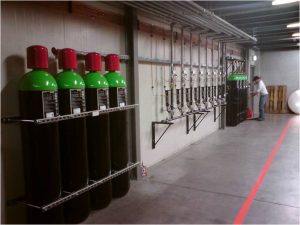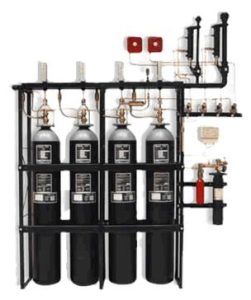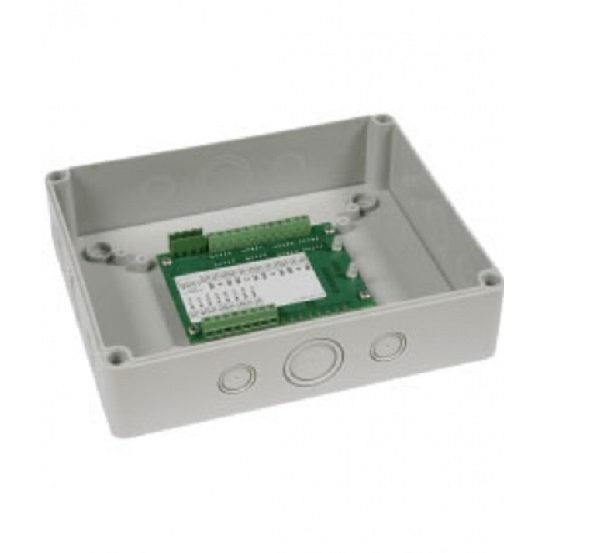
A gas extinguishing system is a fire extinguishing system that extinguishes fire with the help of a gaseous extinguishing agent either through oxygen displacement (reduction of oxygen content) or physical effects (heat extraction). In contrast to a sprinkler system, a gas extinguishing system is designed to extinguish and not only suppress fire.
Gas extinguishing systems are used when water, foam or powder extinguishing systems are not effective or if extinguishing with the above-mentioned extinguishing agents could cause significant damage. Typical areas of use include all types of electrical switch rooms, IT and server rooms.
Gas extinguishing systems are the “cleanest” extinguishing systems. Extinguishing gases have no influence on conventional electrical systems such as servers, etc. A range of different extinguishing gases can be used for the extinguishing system. The specific properties of the different extinguishing gases also define their area of use. arkafire has already designed, hydraulically calculated and constructed a large number of gas extinguishing systems. arkafire has developed in-depth expertise through continuous employee training.
arkafire offers the best solution for every application. The unique market position of the company also pays dividends for the customers. arkafire has the freedom to develop the best and most efficient extinguishing gas solution with the customer as it is able to choose from a wide range of options.
Areas of use of gas extinguishing systems include for example:
- IT systems and computer rooms
- Archive rooms, document safes
- Emergency call centres, flight navigation and control towers, mobile phone transmitter stations, internet service provider centres, television, radio and control rooms, microwave substations.
- Art galleries, libraries, film projector rooms, museums
- Medical sector: imaging systems, operating rooms, mobile stations
- Industrial facilities such as laboratories, control rooms, offshore drilling platforms, robotic equipment
- Emergency power generators, battery compartments, low-voltage compartments, cable compartments, etc.
- Flight simulators, ships, military vehicles
Extinguishing agent
Oxygen-displacing extinguishing gases – inert gases and carbon dioxide (CO2) The extinguishing effect of inert gases such as argon, nitrogen and carbon dioxide (in principle, this is not an inert gas and is therefore unsuitable for class D fires) is achieved through the displacement of atmospheric oxygen. This is known as the smothering effect and occurs if the necessary specific limit value for combustion is fallen short of. In most cases the fire will extinguish after a reduction of oxygen to approx. 13% volume. In addition, the available air volume must only be displaced by roughly a third which corresponds to an extinguishing gas concentration of 34% volume. For burning substances which require significantly less oxygen to burn, an increase of the extinguishing gas concentration is necessary, for example, for ethylene, carbon monoxide and hydrogen. As the extinguishing gases argon and carbon dioxide are more dense than ambient air, they penetrate particularly quickly and rigorously through the area to be extinguished.
In order to improve the extinguishing properties, mixtures of the above-mentioned gases can also be used, for example, Inergen.

Carbon dioxide is primarily suitable for fighting fire classes B and C. Due to its physical properties, carbon dioxide is the only extinguishing gas that is also used in fire extinguishers and fire extinguishing devices. In stationary fire extinguishing systems, carbon dioxide is stored in a liquefied state in high-pressure steel cylinders or cooled to −20 C in large low-pressure containers. By storing it as a liquid, significantly larger volumes of extinguishing agent can be stored efficiently. As carbon dioxide is harmful to health in high concentrations, occupational insurance companies prescribe particular protective measures in the event of an exceeding of a limit value of more than 5% volume.
Carbon dioxide is primarily used as an extinguishing agent in electrical and electronic systems because, unlike all water-based extinguishing agents and the majority of powders, it is not electrically conductive. When designing the systems, attention must be paid to the fact that carbon dioxide is a respiratory poison.
Primary extinguishing effect: Smothering
(Secondary extinguishing effect: Cooling – practical but rarely required)
Argon – IG-01
Argon is an inert gas obtained from the ambient air that is stored as an extinguishing agent for stationary fire extinguishing systems as a compressed gas in high-pressure steel cylinders. The maximum operating pressure is currently 300 bar. Argon is not poisonous. However, when forming the necessary extinguishing concentration, particularly in the event of a fire, a risk may arise from the combustion gases and lack of oxygen. Argon makes up 0.93% of the earth’s atmosphere. Its density in relation to air is 1.38:1. Its own density and high inertness (“real” inert gas) means that argon is advantageous to nitrogen in certain cases, e.g. as an extinguishing gas for metal fires.
Note: High extinguishing concentrations of this gas can, in certain cases, put lives at risk through a lack of oxygen.
Primary extinguishing effect: Smothering
Nitrogen – IG-100
Nitrogen is a colourless, odourless and tasteless gas that is makes up 78.1% of the earth’s atmosphere. Its density in relation to air is 0.967:1. As an extinguishing agent for stationary fire extinguishing systems, nitrogen is stored as a compressed gas in high-pressure steel cylinders. At an atmospheric temperature of +15 C, the maximum operating pressure is currently 300 bar. Nitrogen is not poisonous. However, here too when forming the necessary extinguishing concentration particularly in the event of a fire, risks may arise from the combustion gases and lack of oxygen.
Note: High extinguishing concentrations of this gas can, in certain cases, put lives at risk through a lack of oxygen.
Primary extinguishing effect: Smothering
Argonite® – IG-55
Argonite is a mixture of 50% nitrogen and 50% argon. The mixture of argon which is relatively dense compared to air, with the less-dense nitrogen leads to an optimal mixing throughout the extinguishing area. The use of this is mainly only effective in abnormally high rooms.
Inergen® – IG-541
Inergen is the brand name for a mixture of 52% nitrogen, 40% argon and 8% carbon dioxide. The advantage of this mixture is the unique character of carbon dioxide (CO2). In the event of a lack of oxygen, it accelerates respiration so that the person in the room continues to have an oxygen supply. As Inergen is more expensive than nitrogen or argon, it is largely used in rooms which are subject to specific safety regulations.

Chemically-acting extinguishing gases
After the Montreal Protocol ruled that the remaining Halons 1211 (bromochlorodifluoromethane) and 1301 (bromotrifluoromethane) were to be taken off the market, several companies (e.g. DuPont, 3M, Great Lakes Chemical Corporation) found new fire-extinguishing gases which are non-problematic with regard to their ozone depletion potential (ODP). The extinguishing effect is caused through a disruption of the combustion process (interruption of the chain reaction). In contrast to smothering through inert gases and CO2, this procedure requires a significantly lower volume of extinguishing agent.
Novec 1230 ® (Keton)
The extinguishing agent Novec 1230 (ISO-certification FK-5-1-12) is a colourless, almost odourless liquid which is contained in carbon, fluoride and oxygen molecules (chemical formula CF3CF2C(O)CF(CF3)2). Strictly speaking it is not a Halon but a fluorinated ketone (perfluorinated ethyl isopropyl ketone). The extinguishing effect of Novec 1230 in stationary fire extinguishing systems is due to a homogeneous inhibition (disruption of the combustion chain reaction). The molecule is not electrically conductive. With a global warming potential (CO2 equivalent) of 1, it has the lowest value of all currently approved chemical extinguishing agents and disintegrates within a few days under solar radiation.
FM 200 (HFC227ea) ®
FM-200 is the brand name from the company Great Lakes for 1,1,1,2,3,3,3-Heptafluoropropane, also known as HFC-227ea. FM-200 belongs to the class of fluorinated hydrocarbons (HFCs) which are exclusively made up of carbon, fluoride and hydrogen atoms. The effect consists of cooling the flame and disrupting the chemical reaction of the combustion process. If exposed to flames, the FM-200 will emit small quantities of free radicals on the fire which inhibit the chain reactions responsible for combustion. Another important aspect is that FM-200 is not harmful to sensitive devices. It is a clean, gaseous substance without particles or oily residue. It does not cause a significant reduction of the oxygen content and is therefore also suitable for human-occupied premises. After it has been activated, it can be extracted through simple ventilation measures.
HFC-125
HFC-125 is a colourless, odourless and non-conductive gas. As with the other chemical extinguishing gases, it extinguishes fires through the extraction of heat. HFC-125 has the same physical properties as Halon 1301, however, it is not an ozone-depleting substance.
FE-13
FE-13 is a high-pressure extinguishing gas which is produced by the company DuPont. This extinguishing gas also works through the absorption of heat. Due to its own high vapour pressure, FE-13 does not require an additional carrier gas (nitrogen) when filling the extinguishing gas cylinder. FE-13 is best suited for the protection of goods in cooled rooms and rooms with a height of up to 7.5 metres. The no-observed-adverse-effect-level for this extinguishing agent is 50% and there is currently no extinguishing agent on the market with such a high safety factor for people in a room.



